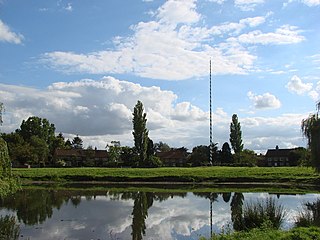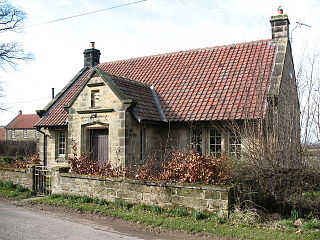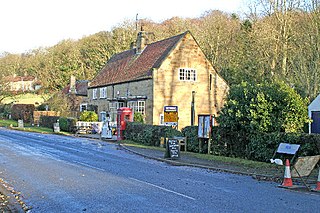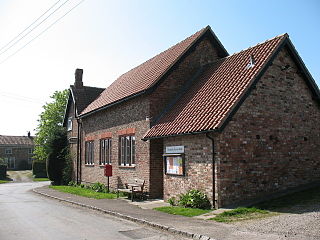
Harewood is a village, civil parish, former manor and ecclesiastical parish, in West Yorkshire, England, today in the metropolitan borough of the City of Leeds. The civil parish population at the 2011 census was 3,734.

Osbaldwick is a village and civil parish in the unitary authority of the City of York in North Yorkshire, England. The population of the civil parish as taken at the Census 2011 was 2,902. It has been in existence since at least the 11th century, and was declared a conservation area in 1978. It is the burial place of the nun Mary Ward.

Braunton is a large village, civil parish, ecclesiastical parish and former manor in Devon. The village is situated 5 miles (8 km) west of Barnstaple. It is one of the largest villages in Devon with a population at the 2021 census of 10,217 people. There are two electoral wards. Their joint population at the above census was 8,218. Within the parish is the fertile, low-lying Braunton Great Field, which adjoins the undulating Braunton Burrows, the Core Area in North Devon Biosphere Reserve, the largest psammosere in England. It confronts the Atlantic Ocean at the west of the parish at the large beach of Saunton Sands, one of the South West's international-standard surfing beaches.

Kilburn is a village in the civil parish of Kilburn High and Low, in the Hambleton District in the county of North Yorkshire, England. It lies on the edge of the North York Moors National Park, and 6.2 miles (10 km) north of Easingwold.

Coxwold is a village and civil parish in the Hambleton District of North Yorkshire, England, in the North York Moors National Park. It is 18 miles north of York and is where the Rev. Laurence Sterne wrote A Sentimental Journey.

Hetton is a small Dales village in the civil parish of Hetton-cum-Bordley, in the North Yorkshire district of North Yorkshire, England, situated 5.75 miles north of Skipton by the B6265 road. It is the largest settlement in the parish of Hetton-cum-Bordley. The population of the former civil parish of Hetton taken at the 2011 Census was 155.

Overton is a small village and civil parish in the Hambleton district of North Yorkshire, England, about 4 miles (6.4 km) north-west of York. The population of civil parish taken at the 2011 Census was less than 100. Details are included in the civil parish of Shipton, North Yorkshire. The East Coast Main Line passes to the east, not far from the village.

Oulston is a village and civil parish in Hambleton district of North Yorkshire, England. It lies about 3 miles (5 km) north-east of Easingwold. Remains of a Roman villa have been found in the area. The village is within the Howardian Hills Area of Outstanding Natural Beauty

Firby is a small village and civil parish in North Yorkshire, England. It lies 1-mile (1.5 km) south of Bedale. The population of the parish was estimated at 30 in 2015. At the 2011 Census the population was included with the civil parish of Bedale, and not counted separately.

Nun Monkton is a village and civil parish in the Harrogate district of North Yorkshire, England. It is situated 8 miles (13 km) northwest of York at the confluence of the rivers Ouse and Nidd. Cottages and houses are grouped around a village green of 20 acres (81,000 m2) with a duck pond and a maypole. The Ouse is navigable for another 19 miles (30 km) and river traffic played an important part in the village's life until the middle of the twentieth century.

Upsall is a hamlet in and civil parish in the Hambleton district of North Yorkshire, England. It is situated approximately four miles north-east of Thirsk. Upsall is part of the Upsall and Roxby estates owned by the Turton family. The population of the civil parish was estimated at 60 in 2014.

Oswaldkirk is a small village and civil parish 4 miles (6.4 km) south of Helmsley and 20 miles (32 km) north of York in North Yorkshire, England. It is named after the village church of St Oswald, King and Martyr, the Anglo-Saxon King of Northumbria who was slain by the pagan, Penda in 642. There was previously a Catholic church, dedicated to St Aidan, which closed in 2020. The population of the village as taken at the 2011 census was 230.

Speeton is a village in the civil parish of Reighton, in North Yorkshire, England. It lies near the edge of the coastal cliffs midway between Filey and Bridlington. It is North Yorkshire's easternmost settlement, but historically lay in the East Riding of Yorkshire until local government re-organisation in 1974. It was part of the Borough of Scarborough from 1974 until 2023.

Cowesby is a village and civil parish in the Hambleton District of North Yorkshire, England. Part of the village including The Cowesby Hall Estate is within the North York Moors National Park and about 7 miles (11 km) north of Thirsk. The population of the civil parish was estimated at 70 in 2014.

Thimbleby is a small village and civil parish in the Hambleton District of North Yorkshire, England, it is in the North Yorks Moors and close to the village of Osmotherley and the Cleveland Way, 6 miles (9.7 km) east of Northallerton. The population of the civil parish as of the 2011 census was 258.

Normanby is a village and civil parish in the Ryedale district of North Yorkshire, England. It is about 4 miles (6.4 km) west of Pickering. It lies on the main road between Malton and Kirkbymoorside.

Brandsby is a village in North Yorkshire, England. The village is the main constituent of the Brandsby-cum-Stearsby Civil Parish in the District of Hambleton. The village is mentioned in the Domesday book. It lies between Easingwold and Hovingham, some 12.3 miles (19.8 km) north of York.

Newburgh Priory is a Grade 1 listed Tudor building near Coxwold, North Yorkshire, England.

Thirkleby High and Low with Osgodby is a civil parish in North Yorkshire, England. The parish includes the villages of Great Thirkleby and Little Thirkleby and the scattered hamlet of Osgodby. The similarly named medieval settlement of Thirkleby Manor is around 30 miles north, in the parish of Kirby Grindalythe, Ryedale District. The population of the civil parish taken at the 2011 Census was 266.

New Forest is a civil parish in North Yorkshire, England. It lies 6 miles (10 km) west of Richmond.





















